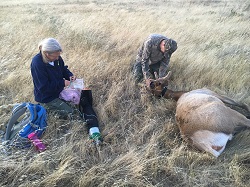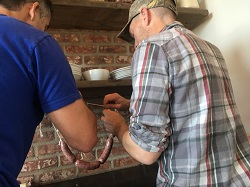
As an 11-year wildlife biologist for CDFW’s Central Region, Nathan was involved in several captures, collars and relocations of California’s native tule elk.

Away from work, Nathan enjoys preparing wild game. Here he makes sausage out of wild duck.
Nathan Graveline was hired as CDFW’s Big Game Program supervisor in March 2019 after spending his entire career in the field as a wildlife biologist. Now based in Sacramento, Nathan supervises a team of headquarters biologists and research staff who support California’s deer, elk, pronghorn and desert bighorn sheep conservation and management programs.
Nathan spent the previous 11 years as CDFW’s wildlife biologist for Mariposa and Tuolumne counties. He joined CDFW full time as a deer biologist in 2001 after working as a seasonal aid for three summers at the Mendota Wildlife Area and later served as a scientific aid for CDFW’s upland game bird and deer programs.
Nathan was born and raised in Fresno and holds a degree in forestry and wildlife management from Cal Poly San Luis Obispo.
It’s still deer season in some parts of the state. How would you assess the status of California’s deer herds?
I think most of our populations are fairly stable. There are certainly areas that we are concerned about. The X zones – X12, X9a and X9b – still have not recovered from the harsh winter in 2016. We were hoping to see some recovery there and to potentially increase tags again. But the data are just not supporting increasing tags. The good news is that we have data to make those kinds of assessments.
Across what we call our opportunity zones – the A Zone and D zones – things don’t change that much in terms of populations and hunter success.
Is it an oversimplification to say that resident deer herds are doing well and migratory deer herds are not?
Probably not. We have two species of deer in California – Columbian black-tailed deer on the coast and mule deer in the eastern part of the state. And there are some hybrids in between.
We’ve done fecal DNA analysis on black-tailed deer in Marin County, for instance, and we got population densities that were through the roof, as high as 30 deer or more per square kilometer. Now, deer hunting is limited in most parts of Marin County, there are very few predators, and food is available year-round because people have yards with plants that supply a food source. And that’s similar to what we see in the Sierra foothill communities. Predation is low, you have more water, more forage and the deer populations tend to be more stable. Even in a drought, people still have yards that can provide food and water.
By contrast, our migratory mule deer herds are subject to every possible environmental condition plus other factors – development, highways, human recreation – that can impact habitat corridors and migration.
Are you a deer hunter?
I am. I think I shot my first deer in 2004. It took me a couple of years to get the first one. I’ve been consistently deer hunting since then. I try to feed my family with venison mostly. We don’t buy beef. Venison is our primary meat source.
Some hunters are discouraged about the state of deer hunting in California. The general sense is it’s much harder than it used to be and much tougher to be successful compared to other states. Is there any advice or words of encouragement you can offer?
I think there is some really good hunting out there. We have an amazing amount of opportunity in California. We have a lot of over-the-counter tags (you can purchase without applying through a lottery), but that also means you have a lot of competition in the field. So just thinking outside of the box with tactics is always a good thing.
Take advantage of our wilderness areas. We have a lot of wilderness in this state – roadless areas, federally designated wilderness. Hunters who are willing to get off the beaten path a little bit can find some quiet out there where they can hunt and potentially be by themselves. I don’t think hunters use optics as much as they could, especially on the east side and areas that are more open.
Take advantage of the gear that we have now. The technology has changed so much. It used to be that rangefinders would work out to 400 yards. Now they can range a mile. It’s just amazing. Optics in general are better than they used to be. There are a lot more long-range rifle options out there today, although that takes some practice to become proficient. It’s not something you just pick up and do.
You’re saying California deer hunters need to hunt differently than they did 10 or 20 years ago?
I think so. I hunted Zone X12 (Mono County) two years ago with my dad. We didn’t do a lot of hiking. We did some hikes, but we were primarily road hunting. We saw a ton of deer, and it was because we would stop and glass. We’d get the spotting scope out and just look. I was shocked at how many deer we saw from the roads.
A lot of other hunters were just driving past us – dusting us out. They’d complain in the restaurant later that evening that they didn’t see anything. I think it’s a matter of changing the way we do things. Slowing down. All the quads and mules and side-by-sides that hunters use – you miss a lot of stuff when you use those.
Mountain lions and bears are sore subjects for many deer hunters. To what degree are bears and mountain lions impacting California’s deer herds?
Habitat is the biggest limiting factor for wildlife. But when you have populations that are struggling – for whatever reason, maybe the habitat is not optimal – things like disease and predation can prevent those populations from rebounding.
We all know lions kill a lot of deer. Theoretically, though, if you have quality habitat, the deer populations should be able to handle that and you’re going to have cyclical population cycles among predators and prey.
Maybe the suburban deer issue has shifted some of the balance and lion populations are higher than we might normally see because those lions are now living on the suburban edge. And when the deer aren’t there, the lions can eat goats and sheep – and they do sometimes. And when the deer return in the winter, lions have plenty of deer to feed on. It’s a possibility and something we might discover as we continue collecting data on mountain lion populations.
We do know that bears prey on fawns in their summer range and they also steal mountain lion kills. Those lions then have to go out and kill more deer than they otherwise would. We’ve got that documented. We don’t have any scientific papers published on it as far as I know, but we’ve got lots of camera data to support that. We’ve had GPS-collared deer that were confirmed lion kills, we set up a trail camera, and a bear comes along and steals that deer carcass. It’s a concern, for sure.
To what extent can CDFW improve deer hunting in California?
I think our best option is to work with the land management agencies – BLM, the Forest Service – to try and influence the habitat side of things. I think we can provide them with data on migration routes so that if they are going to be doing a big project in an area we can use that data to help inform that project and undertake appropriate treatments. If it’s winter range, we need to emphasize the importance of winter range habitat for deer and how we can improve that range. We have good relationships with those agencies. But it’s just like anything else, we can always do a better job of communicating, using and sharing the information that we have.
And then we can control to some level the quality of hunting based on our data and the number of deer tags we issue. Typically with the X zones, we try and manage more for a quality hunt. The A, C and D zones are more about opportunity.
So many of our deer seasons in California start earlier than many other states. Is there any discussion to move deer seasons later in the year, closer to the rut, when hunter success would be higher?
The general consensus among deer biologists in the state is that the herds cannot sustain the added pressure of hunting during the rut. If we were to do that, we’d have to reduce tag numbers dramatically. And that’s the tradeoff. If you really want to have late hunts, you have to issue significantly fewer tags.
What about the resident herds that are stable or growing? Are there opportunities to create some additional deer hunts for the public?
Yes, we are looking at the Central Valley river corridors – the Merced River, the San Joaquin River, the Tuolumne River-- and some of the national wildlife refuges and our state wildlife areas nearby where we see deer numbers increasing. Those would be A Zone hunts. The U.S. Fish and Wildlife Service is interested in doing some deer population assessments and potentially holding hunts on their land, and we are coordinating with them. Some of our Merced County wildlife areas – Los Banos, North Grasslands – would be good candidates to hold deer hunts – at least youth hunts. That would require some regulatory changes to permit deer as a species of take, but we are definitely looking at that.
Tell us something about yourself many people would be surprised to learn.
I do a lot of foraging – mushroom hunting and general forest foraging. I love cooking. I love to make charcuterie, sausages and cured meats with wild game. There is a lot that goes into harvesting a deer or an elk or whatever species it is – a lot of time and money and personal effort and all of that. So to me, honoring that wild animal and turning that wild game into something really special – something more than what you’d do with a chunk of beef – is important.
CDFW Photo. Top Photo: Photo Captions: Nathan Graveline with the X12 Zone 3x3 buck he harvested in 2017 with his father.